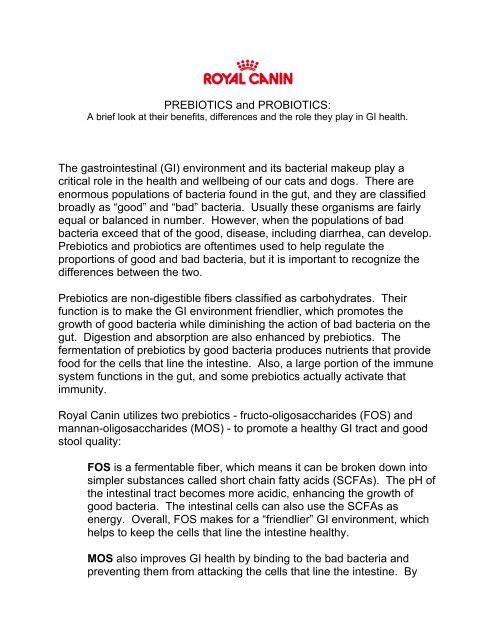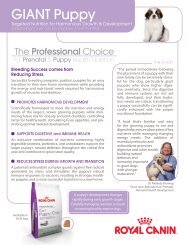PREBIOTICS and PROBIOTICS: The ... - Royal Canin USA
PREBIOTICS and PROBIOTICS: The ... - Royal Canin USA
PREBIOTICS and PROBIOTICS: The ... - Royal Canin USA
Create successful ePaper yourself
Turn your PDF publications into a flip-book with our unique Google optimized e-Paper software.
<strong>PREBIOTICS</strong> <strong>and</strong> <strong>PROBIOTICS</strong>:<br />
A brief look at their benefits, differences <strong>and</strong> the role they play in GI health.<br />
<strong>The</strong> gastrointestinal (GI) environment <strong>and</strong> its bacterial makeup play a<br />
critical role in the health <strong>and</strong> wellbeing of our cats <strong>and</strong> dogs. <strong>The</strong>re are<br />
enormous populations of bacteria found in the gut, <strong>and</strong> they are classified<br />
broadly as “good” <strong>and</strong> “bad” bacteria. Usually these organisms are fairly<br />
equal or balanced in number. However, when the populations of bad<br />
bacteria exceed that of the good, disease, including diarrhea, can develop.<br />
Prebiotics <strong>and</strong> probiotics are oftentimes used to help regulate the<br />
proportions of good <strong>and</strong> bad bacteria, but it is important to recognize the<br />
differences between the two.<br />
Prebiotics are non-digestible fibers classified as carbohydrates. <strong>The</strong>ir<br />
function is to make the GI environment friendlier, which promotes the<br />
growth of good bacteria while diminishing the action of bad bacteria on the<br />
gut. Digestion <strong>and</strong> absorption are also enhanced by prebiotics. <strong>The</strong><br />
fermentation of prebiotics by good bacteria produces nutrients that provide<br />
food for the cells that line the intestine. Also, a large portion of the immune<br />
system functions in the gut, <strong>and</strong> some prebiotics actually activate that<br />
immunity.<br />
<strong>Royal</strong> <strong>Canin</strong> utilizes two prebiotics - fructo-oligosaccharides (FOS) <strong>and</strong><br />
mannan-oligosaccharides (MOS) - to promote a healthy GI tract <strong>and</strong> good<br />
stool quality:<br />
FOS is a fermentable fiber, which means it can be broken down into<br />
simpler substances called short chain fatty acids (SCFAs). <strong>The</strong> pH of<br />
the intestinal tract becomes more acidic, enhancing the growth of<br />
good bacteria. <strong>The</strong> intestinal cells can also use the SCFAs as<br />
energy. Overall, FOS makes for a “friendlier” GI environment, which<br />
helps to keep the cells that line the intestine healthy.<br />
MOS also improves GI health by binding to the bad bacteria <strong>and</strong><br />
preventing them from attacking the cells that line the intestine. By
using this method, MOS “moves” bad bacteria out of the body in the<br />
feces. Another benefit of MOS is the activation of the immune<br />
system in the gut. This benefits the health of not only the gut, but<br />
also that of the entire animal.<br />
Probiotics, on the other h<strong>and</strong>, are living, microscopic organisms that add to<br />
the numbers of good bacteria in the dog or cat’s GI environment. <strong>The</strong>y are<br />
administered either as a separate dietary supplement or in the pet food<br />
(added by the manufacturer). <strong>The</strong> probiotics must be given in sufficient<br />
quantities [100 million colony forming units (CFU) to 100 billion CFU] to be<br />
beneficial to the pet. In theory, this is a great concept; however, because<br />
probiotics are living organisms, keeping them alive is a challenge.<br />
Manufacturing, storage (including on-shelf at the store), <strong>and</strong> shipping<br />
temperatures must be carefully monitored so that the organisms do not die.<br />
In addition, once ingested by the cat or dog, they must survive stomach<br />
acid <strong>and</strong> bile to reach the gut while still alive.<br />
It is important to recognize the differences <strong>and</strong> benefits of prebiotics <strong>and</strong><br />
probiotics when you’re choosing methods to regulate <strong>and</strong> improve your dog<br />
<strong>and</strong> cat’s GI environment. While both can be beneficial, their uses can<br />
have different impacts on the health of your pet. By utilizing science <strong>and</strong><br />
the appropriate nutrients, pet food diets can help provide optimum nutrition.<br />
Melinda Fleming, DVM<br />
© 2010 <strong>Royal</strong> <strong>Canin</strong> <strong>USA</strong>, INC<br />
References available on request.












